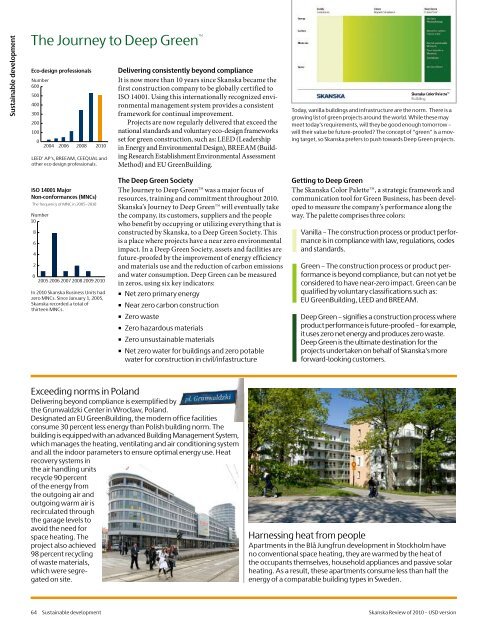Review of 2010 â USD version - Skanska
Review of 2010 â USD version - Skanska
Review of 2010 â USD version - Skanska
You also want an ePaper? Increase the reach of your titles
YUMPU automatically turns print PDFs into web optimized ePapers that Google loves.
Sustainable development<br />
The Journey to Deep GreenTM<br />
Eco-design pr<strong>of</strong>essionals<br />
Number<br />
600<br />
500<br />
400<br />
300<br />
200<br />
100<br />
0<br />
2004<br />
2006<br />
2008<br />
<strong>2010</strong><br />
LEED’ AP’s, BREEAM, CEEQUAL and<br />
other eco design pr<strong>of</strong>essionals.<br />
Delivering consistently beyond compliance<br />
It is now more than 10 years since <strong>Skanska</strong> became the<br />
first construction company to be globally certified to<br />
ISO 14001. Using this internationally recognized environmental<br />
management system provides a consistent<br />
framework for continual improvement.<br />
Projects are now regularly delivered that exceed the<br />
national standards and voluntary eco-design frameworks<br />
set for green construction, such as: LEED (Leadership<br />
in Energy and Environmental Design), BREEAM (Building<br />
Research Establishment Environmental Assessment<br />
Method) and EU GreenBuilding.<br />
Today, vanilla buildings and infrastructure are the norm. There is a<br />
growing list <strong>of</strong> green projects around the world. While these may<br />
meet today’s requirements, will they be good enough tomorrow –<br />
will their value be future-pro<strong>of</strong>ed? The concept <strong>of</strong> “green” is a moving<br />
target, so <strong>Skanska</strong> prefers to push towards Deep Green projects.<br />
ISO 14001 Major<br />
Non-conformances (MNCs)<br />
The frequency <strong>of</strong> MNC in 2005–<strong>2010</strong><br />
Number<br />
10<br />
8<br />
6<br />
4<br />
2<br />
0<br />
2005 2006 2007 2008 2009 <strong>2010</strong><br />
In <strong>2010</strong> <strong>Skanska</strong> Business Units had<br />
zero MNCs. Since January 1, 2005,<br />
<strong>Skanska</strong> recorded a total <strong>of</strong><br />
thirteen MNCs.<br />
The Deep Green Society<br />
The Journey to ISO Deep 14001 Green allvarliga TM was avvikelser a major focus <strong>of</strong><br />
resources, training (Major and Non-Conformaties, commitment MNC) throughout <strong>2010</strong>.<br />
identifierade under 2005–<strong>2010</strong><br />
<strong>Skanska</strong>’s Journey to Deep Green TM will eventually take<br />
the company, its<br />
Antal<br />
customers, suppliers and the people<br />
10<br />
who benefit by occupying or utilizing everything that is<br />
constructed by <strong>Skanska</strong>, 8 to a Deep Green Society. This<br />
is a place where projects 6 have a near zero environmental<br />
impact. In a Deep Green Society, assets and facilities are<br />
4<br />
future-pro<strong>of</strong>ed by the improvement <strong>of</strong> energy efficiency<br />
and materials use 2 and the reduction <strong>of</strong> carbon emissions<br />
and water consumption. 0 Deep Green can be measured<br />
2005 2006 2007 2008 2009 <strong>2010</strong><br />
in zeros, using six key indicators:<br />
• Net zero primary<br />
Under <strong>2010</strong>,<br />
energy<br />
hade <strong>Skanska</strong>s<br />
13 affärsenheter 0 MNCs.<br />
• Near zero carbon<br />
Sedan 1<br />
construction<br />
januari 2005, har totalt<br />
13 MNCs identifierats i <strong>Skanska</strong>s<br />
• Zero waste<br />
13 affärsenheter.<br />
• Zero hazardous materials<br />
• Zero unsustainable materials<br />
• Net zero water for buildings and zero potable<br />
water for construction in civil/infastructure<br />
Getting to Deep Green<br />
The <strong>Skanska</strong> Color Palette TM , a strategic framework and<br />
communication tool for Green Business, has been developed<br />
to measure the company’s performance along the<br />
way. The palette comprises three colors:<br />
Vanilla – The construction process or product performance<br />
is in compliance with law, regulations, codes<br />
and standards.<br />
Green – The construction process or product performance<br />
is beyond compliance, but can not yet be<br />
considered to have near-zero impact. Green can be<br />
qualified by voluntary classifications such as:<br />
EU GreenBuilding, LEED and BREEAM.<br />
Deep Green – signifies a construction process where<br />
product performance is future-pro<strong>of</strong>ed – for example,<br />
it uses zero net energy and produces zero waste.<br />
Deep Green is the ultimate destination for the<br />
projects undertaken on behalf <strong>of</strong> <strong>Skanska</strong>’s more<br />
forward-looking customers.<br />
Exceeding norms in Poland<br />
Delivering beyond compliance is exemplified by<br />
the Grunwaldzki Center in Wrocław, Poland.<br />
Designated an EU GreenBuilding, the modern <strong>of</strong>fice facilities<br />
consume 30 percent less energy than Polish building norm. The<br />
building is equipped with an advanced Building Management System,<br />
which manages the heating, ventilating and air conditioning system<br />
and all the indoor parameters to ensure optimal energy use. Heat<br />
recovery systems in<br />
the air handling units<br />
recycle 90 percent<br />
<strong>of</strong> the energy from<br />
the outgoing air and<br />
outgoing warm air is<br />
recirculated through<br />
the garage levels to<br />
avoid the need for<br />
space heating. The<br />
project also achieved<br />
98 percent recycling<br />
<strong>of</strong> waste materials,<br />
which were segregated<br />
on site.<br />
Harnessing heat from people<br />
Apartments in the Blå Jungfrun development in Stockholm have<br />
no conventional space heating, they are warmed by the heat <strong>of</strong><br />
the occupants themselves, household appliances and passive solar<br />
heating. As a result, these apartments consume less than half the<br />
energy <strong>of</strong> a comparable building types in Sweden.<br />
64 Sustainable development <strong>Skanska</strong> <strong>Review</strong> <strong>of</strong> <strong>2010</strong> – <strong>USD</strong> <strong>version</strong>

















